| Devices and Armorial Bearings of the Barons of Newton and their Kindred.
This is a fragment of the seal of Warin Banastre, son of Robert Banastre, and heir to his brother Richard, who died 23rd April, 1205. |
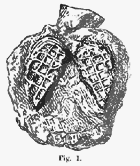 |
The deed to which this seal is appended being without date, it is uncertain whether it was used by the son or by the grandson of Thurstan, brother and successor to Warin, both of whom bore the name of Robert.
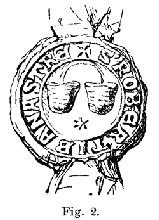
fig. 2
These seals bear the device of dossers (paniers) which have been by some called water bougets.
This device appears as a charge in the arms of Banesters of Darwen, in the Visitation of 1567,viz., sable, two dossers joined in fess, argent; on a chief, gules, three fleur-de-lis, or.
An ancient coat of this family is also there recorded as argent, a water bouget between four fleur-de-lis, sable.
Philip de Orreby, justice of Chester, who had the wardship of Thurstan Banastres heir, bore a coat ermine, charged with five chevronels,gules. The inference that Clementia., wife of Robert Fitz Thurstan, was his daughter, receives confirmation from the circumstance that after this alliance we find the Banastres using a coat of three chevrons.
The tinctures were re-versed, as shown by “the Roll of Arms of the reign of Edward II”, edited by Sir Nicholas Harris Nicolas, p. 89:- “Sire William Banastre, de goules a iij cheverons de argent.”
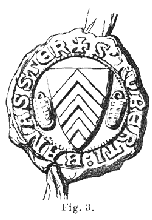 fig. 3 |
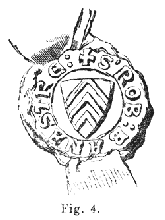 fig. 4 |
The dates of the deeds to which the two seals in the margin were attached prove them to have been used by the last Robert Banastre, son of Clementia.
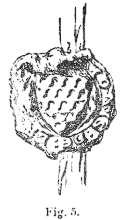
fig. 5
John, son of Robert de Langeton, Lord of the Manor of West Langeton in the county of Leicester, who married Alice, grand-daughter and heiress of Robert Banastre, sealed with a shield vair; probably derived, either through kindred or affection, from that of Marmion, under which family some of his property was held.
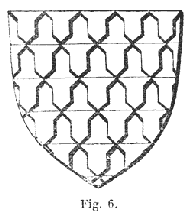 fig. 6 |
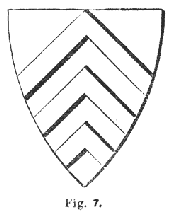 fig. 7 |
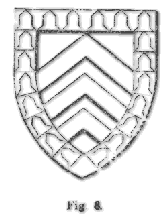 fig. 8 |
|
By his son, Robert de Langeton, the arms of the two families were borne amalgamated.
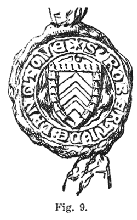 fig. 9 |
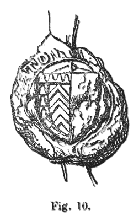 fig. 10 |
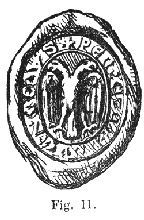 fig. 11 |
The seals drawn above are those of Robert, the second Baron of the line of Langton and of Margaret his wife. They were appended to indentures made in the 15th year of the reign of Edward III. (1342)
The charge of the arms impaled is obliterated. It may probably have been a spread eagle, which after this time came into use in the family.
Randle Holme records in a window at Wigan Church an impaled coat, on the dexter side, argent, three chevrons gules; on the sinister, argent, an eagle displayed with two heads vert, beaked and legged or. This coat was probably derived from Orrel, for in the preceding account of the descents of the Langton family, it is shewn that there was, about this date, an alliance with that of Orrel, and there was found amongst the muniments at Lyme the seal of William, son of Richard de Orel, 13 Edward 1, as here represented.
The Langtons of Lowe, Lords of the Manor of Hindley, were the descendants of Robert, the second son of the before-named Robert, and on their line the paternal estate in Leicestershire, with other property, was settled.
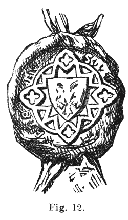
fig. 12
Represents the seal of John de Langton, the second of this line, rather defaced, but known to have borne an eagle displayed, from the deed of 42nd year of Edward III. (1369), to which it was affixed, having been copied with its seal. Vide Harl. MSS, c. 2312.
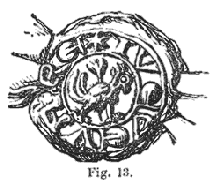
fig. 13
A seal of the same. He used several devices; one has the appearance of a trophy, another is a bird of prey, with a smaller bird in its talons.
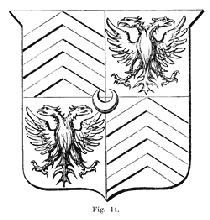
fig. 14
Arms of Langton of Lowe, as in Grafton MS Coll. of Arms.
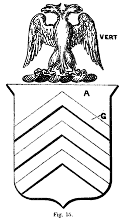
fig. 15
Arms of Langton of Lowe, entered at the Visitation of 1664.
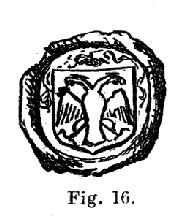
fig. 16
Seal used by Edward Langton, the last of Lowe, in making his will, Sept. 1, 1731.
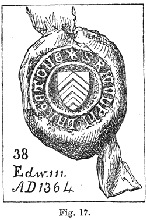
fig. 17
Ralph, the grandson and successor of Robert the second Baron of this line of Langton, abandoned the bordure of the paternal arms, and sealed with a coat of three chevrons only. The tinctures had been reversed again when used by the Langtons, the field being argent, the chevrons gules. (Roll of Arms of Knights at the Siege of Calys.)
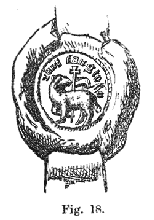
fig. 18
Impression of the signet ring of Ralph, grandson of the foregoing, to an English deed, 6th May, 1427, from the muniments at Trafford.
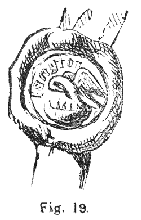
fig. 19
His grandson, Richard, sealed, in the 17th Edward IV (1478), with the device of a pelican vulnerant.
The ring is in existence. It was turned up on the point of a ploughshare some years ago, in Brindle, a township contiguous to Walton-le-Dale. It has a legend engraved inside the ring, “DE Box CUER.”
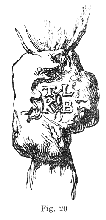
fig. 20
Seal of Sir Thomas Langton, who married, first, the daughter of Lord Mont-eagle, and second, the daughter of Thomas Talbot.
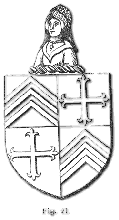
fig. 21
Arms of Langton, Baron of Newton, given in the Visitation of 1567. In the original edition of Gregsons Fragments and with the pedigree in Bainess History of Lancashire, the crest is improperly represented by two figures on the wreath. Some copies of the Visitation of 1567 having given the crest as seen both in profile and in full face, probably led to this error.
In Graftons MS the figure is represented as undraped, though wearing a headdress and necklace, while a MS, said to nave been copied from one of the time of Edward IV, (Harl. MSS, cod. 2076), gives the female bust, proper, with head tire, or, between two wings erect, argent.
At Wooton Lodge. where this crest appears over the quarterly coat of Fleetwood and Langton, the garment is cut square on the breast.
The second and third quarters are doubtless intended for Banastre, under the impression that the chevrons represented the paternal coat of Langton ; but, as we have seen above, they were derived from Banastre. The cross patonce sable never appears to have been borne by the Barons of Newton, but to have been used by the junior line of Banastre, settled in Leyland Hundred.
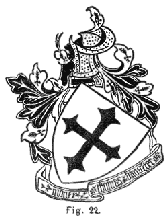
fig. 22
The Visitation of 1533 gives the Banastre quarter as a cross moline, but the engraving in the margin (fig. 22) of Sir Thomas Banastres garter plate in St. Georges Chapel, Windsor, shows that the charge in his arms was a cross patonce.
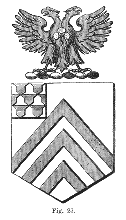
fig. 23
William Langton, Recorder of Liverpool and M.P. for Preston in the Long Parliament, was the eldest son of Roger Langton of Broughton Tower.
He bore, on the authority of William Riley, Norroy in the time of the Commonwealth, party per pale, argent and or, three chevrons, gules, with the crest of a Talbot sejant regardant, sable, the ears argent. All the Acts of the College of Arms during the Commonwealth being made void at the Restoration,
Dugdale cancelled these arms at the Visitation of 1664, and substituted those in the margin, where the ancient paternal coat is revived in the canton.
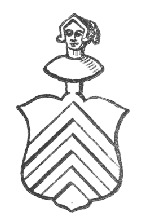
fig. 24
This family is now represented by Mr. William Langton, of Liverpool. Langton Arms and Crest, carved on a mantel-piper: at Samlesbury Hall.
From an original text I recently purchased, written by William Beamont, Esq. which he read as a lecture to the Newton-in-Makerfield Mechanics Institute , Feb 22nd, 1872.
This version is transcribed and edited by Steven Dowd for use in the Newton-le-willows Website © 2004



